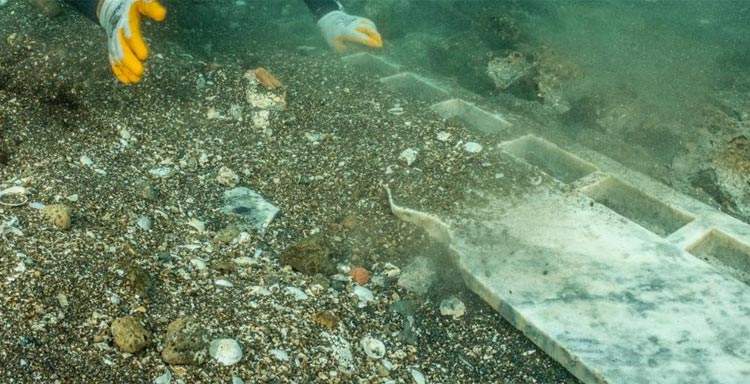The waters of the Bay of Naples continue to be a source of relevant discoveries. A few days ago we gave news of the discovery of a mosaic with surprising lines and colors in terms of shine and preservation, in the Underwater Archaeological Park of Baia. And last April 11, on the occasion of the National Day of the Sea, the ministers of culture Gennaro Sangiuliano and of the sea Nello Musimeci announced that precisely in the Neapolitan gulf, in the waters in front of Pozzuoli, the exact location of the ancient Temple of the Nabateans has been identified thanks to the discovery of two marble altars from the Roman period (datable to the first half of the first century AD). The Nabataeans were a Middle Eastern merchant people who had an enclave in the Phlegraean Fields.
The news is the kind that gives a breakthrough in that the two altars discovered in the heart of the ancient commercial port of Roman Puteoli manage to locate areas hitherto only hypothesized (the Great Temple, warehouses, trading rooms, buildings for imperial administration and major road axes) giving a sense of measure of the great archaeological material still submerged that must be there.
“This is,” said Minister Gennaro Sangiuliano visibly satisfied, “an extraordinary result, the result of collaboration between the peripheral organs of the Ministry of Culture, the academic and scientific realities of the area and the Carabinieri’s underwater unit in Naples. Ancient Puteoli reveals another of its treasures, the exact location of which was hitherto unknown, testifying to the wealth and breadth of commercial, cultural and religious exchanges in the Mediterranean basin in the ancient world. Rome’s past never ceases to amaze, and I am happy that this is happening on the National Day of the Sea, which could not have had a better celebration.”
Until the discovery announced today there remained uncertainty about the exact location of the Temple, and the result was possible thanks to the use of special precision topographical instruments and intensive work coordinated between Soprintendenza Archeologia Belle Arti e Paesaggio of Naples and the University of Campania Vanvitelli, Scuola Superiore Meridionale for the coordination of underwater activities and the fundamental support of the Carabinieri Subacquei of Naples.
The Nabataeans, whose capital was the famous city of Petra, were nomadic and dedicated to trade between the East and Rome, but they had chosen on a permanent basis the Puteolian port, which at the time was the Mediterranean’s major trading port for their trade. Of their mercantile enclave on the Gulf of Naples, the only one outside the motherland, bases and slabs inscribed with dedications - in Latin - to the tutelary god Dusares, found on the seabed of Pozzuoli on several occasions between the 18th century and the 1880s, and later in the collections of the Museums of Naples and the Aragonese Castle in Baia, were known until now. As mentioned, the location of the landmark sanctuary remained approximate, now identified with precision topographical tools that have allowed the Temple to be included in the larger topographical framework of the vicus Lartidianus. The researches, conducted by Michele Silani of Vanvitelli University, Michele Stefanile of the Southern High School and Maria Luisa Tardugno of the Soprintendenza Archeologia Belle Arti e Paesaggio for the metropolitan area of Naples, have made it possible, in addition to the correct positioning of the Temple, to recognize rooms, warehouses, buildings of the imperial administration and road axes of the ancient port.
The final localization of the altars, which also took place thanks to the active collaboration of the Soprintendenza’s underwater technical assistant Carlo Leggieri and the support offered by the Carabinieri Subacquei del Nucleo di Napoli, with Commander Sandro Bucalo, now allows for a better understanding of the’articulation of this complex sector of the Puteolian port, in which the sacred buildings of the communities of foreigners stood in very close contact with the long rows of warehouses intended to store the many goods in transit through the port of call, ready to be sorted to Campania or redirected directly to Rome.
 |
| In the Bay of Naples discovered the location of the ancient temple of the Nabataeans |
Warning: the translation into English of the original Italian article was created using automatic tools. We undertake to review all articles, but we do not guarantee the total absence of inaccuracies in the translation due to the program. You can find the original by clicking on the ITA button. If you find any mistake,please contact us.